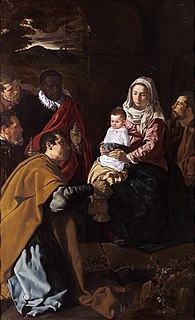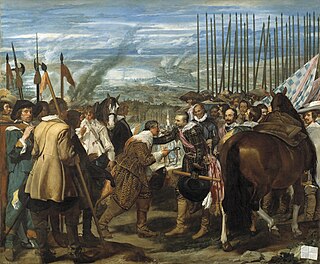 W
WThe Adoration of the Magi is a 1619 Baroque painting by the Spanish artist Diego Velázquez now held in the Museo del Prado. It shows three kings presenting gifts to the Christ child: Melchior, who kneels in the foreground; Balthazar, who stands behind him wearing a red cape and a lace collar; and Caspar, who appears between the other two. An unidentified young man who stands behind Balthazar is looking on. Kneeling near the Virgin's left shoulder is Saint Joseph. The size and format of the painting indicate that it was made for an altarpiece.
 W
WApollo in the Forge of Vulcan, sometimes referred to as Vulcan's Forge, is an oil painting by Diego de Velázquez completed after his first visit to Italy in 1629. Critics agree that the work should be dated to 1630, the same year as his companion painting Joseph's Tunic. It appears that neither of the two paintings were commissioned by the king, although both became part of the royal collections within a short time. The painting became part of the collection of the Museo del Prado, in Madrid, in 1819.
 W
WChrist Crucified is a 1632 painting by Diego Velázquez depicting the Crucifixion of Jesus. The work, painted in oil on canvas, measures 249 × 170 cm and is owned by the Museo del Prado.
 W
WThe Coronation of the Virgin is a painting by Diego Velázquez of the Holy Trinity crowning the Blessed Virgin Mary, a theme in Marian art. It is now at the Museo del Prado.
 W
WMars or Resting Mars is a 1640 painting by Diego Velázquez. It is now in the Prado Museum. The painting was inspired by Il Pensieroso, one of Michelangelo's sculptures for the Medici in the new sacristy of the Basilica of San Lorenzo. This painting is a satirical depiction of the god Mars. It is thought to have been finished around 1639-1640.
 W
WGaspar de Guzmán, Count-Duke of Olivares, on Horseback is an oil on canvas painting by Spanish painter Diego Velázquez, made around the year 1636. It has been in the Museo del Prado in Madrid since its inauguration in 1819.
 W
WLa rendición de Breda is a painting by the Spanish Golden Age painter Diego Velázquez. It was completed during the years 1634–35, inspired by Velázquez's visit to Italy with Ambrogio Spinola, the Genoese-born Spanish general who conquered Breda on June 5, 1625. The painting depicts the exchange of the key of Breda from the Dutch's possession, to the Spanish.
 W
WThe Triumph of Bacchus is a painting by Diego Velázquez, now in the Museo del Prado, in Madrid. It is popularly known as Los borrachos or The Drinkers.
 W
WView of the Garden of the Villa Medici is a small painting by Diego Velázquez of the garden at the Villa Medici in Rome, with some figures standing watching an unseen event, possibly the works behind the scaffolding in the middle of the building in the background. It is now in the Prado. There is some controversy as to its date, with some scholars believing it was made during the artist's first trip to Italy (1629–1631) while others believe its advanced technique indicates it was created on his second trip (1649–1651). Art historian Enriqueta Harris believes that records that came to light in 1976 of repairs made during 1648–49 to the villa, and specifically to the grotto that is boarded up in Velázquez's painting, confirms the later date. There is another version with similar features and the same title, and the two are of similar size and vary little in their execution and manner of depicting the garden.